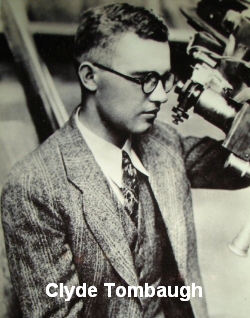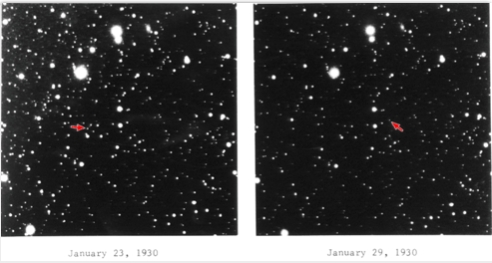¡SkyCaramba! Weekly astronomy blog for the week ending January 24, 2015
It seemed unlikely. A young man out of high school and unsure how he would pay for college ends up working for a professional astronomical observatory and making one of the biggest discoveries of the 20th Century. But  where there’s a will, there’s a way. Clyde Tombaugh had the will.
where there’s a will, there’s a way. Clyde Tombaugh had the will.
Working on his family’s farm in Illinois, the young Tombaugh took an interest in the heavens. After looking through an uncle’s telescope, he longed for his own. Eventually he obtained one from Sears. Then, as now, department store telescopes left something to be desired. Also then, as now, higher quality instruments cost a pretty penny. So Tombaugh made his own. By that time, his family had moved to Kansas.
Tombaugh’s observations and his lack of a college degree helped him get a job at Lowell Observatory in Arizona. The professional astronomers at Lowell needed an employee with a keen interest in the subject who could work alone carefully pointing a telescope, changing photographic films, and noting details night after night. Because they didn’t have a lot of money for staff, they also needed an employee who didn’t expect a high wage.
The event that made Tombaugh famous happened on two nights in 1930. One of his most important tasks was to photograph the same area of the sky twice or more on different nights. The photographs were compared to see if anything in them had moved. Stars move, but not fast enough to detect in pictures taken a few nights apart. However, comets, asteroids, and planets move quite noticeably against the starry backdrop. In February that year, the astronomers at Lowell announced that their employee had discovered the ninth planet orbiting the sun by comparing two photos. The International Astrononomical Union named the new planet Pluto.
Many astronomers, especially those at Lowell, had expected such a discovery. Years before, the observatory’s namesake, Percival Lowell, had concluded that Uranus and Neptune moved a little differently than expected because of the gravitational influence of another planet not yet known. Lowell went so far as to predict an orbit for this Planet X. Pluto appeared where Planet X was supposed to be!
 Using the best understanding at the time of what Pluto was, Tombaugh was celebrated as the discoverer of the solar system’s ninth planet. However, a different understanding started to emerge in the 1990s. That’s when astronomers started discovering other objects orbiting the sun at distances comparable to Pluto’s. Tombaugh, like most people, still thought of Pluto as a planet when he died in 1997. But by 2006, the advancement of scientific understanding led the astronomers to reclassify Pluto as a dwarf planet or a trans-Neptunian object.
Using the best understanding at the time of what Pluto was, Tombaugh was celebrated as the discoverer of the solar system’s ninth planet. However, a different understanding started to emerge in the 1990s. That’s when astronomers started discovering other objects orbiting the sun at distances comparable to Pluto’s. Tombaugh, like most people, still thought of Pluto as a planet when he died in 1997. But by 2006, the advancement of scientific understanding led the astronomers to reclassify Pluto as a dwarf planet or a trans-Neptunian object.
Not everyone likes that. There have been many petition campaigns aimed at getting the IAU to again include Pluto among the classical planets. Whatever your feelings, you cannot deny that Tombaugh’s discovery was remarkable. Remember, those other objects orbiting way out past Neptune weren’t found until imaging technology had advanced far beyond the tools Tombaugh worked with. Those objects are now said to be in the Kuiper Belt. That’s a region in some ways like the asteroid belt between Mars and Jupiter. Clyde Tombaugh discovered a few objects there too. But he’s now understood to have discovered the first known Kuiper Belt object.
It turns out that Pluto doesn’t have enough mass to have affected the movements of Uranus and Neptune. Its own gravity is barely enough to keep a few natural satellites in orbit around it. Indeed, the IAU’s new definition of planet excludes Pluto because its gravity isn’t strong enough to sweep other objects away. Today’s astronomers aren’t looking for Lowell’s Planet X. They feel certain that previous generations of sky watchers just didn’t know as much as they thought about the orbits of Uranus and Neptune. So when they predicted the planets’ locations, they found them in slightly different places.
There are a few reasons to think of Mr. Tombaugh now. The anniversaries of his birth and death are this time of year. But also, right now, a spacecraft is arriving alongside Pluto to begin studying it and its moons. Some of the ashes from Clyde Tombaugh’s cremated body are in a container attached to it.
¡SkyCaramba!